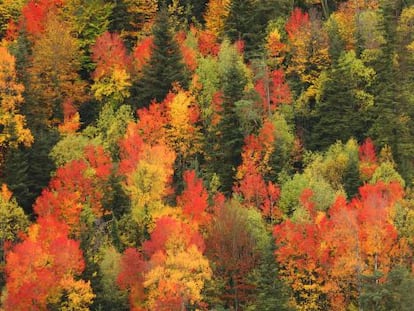After a record-breaking summer in Spain, expect a wet, warm fall
Temperatures forecast to be as much as 1.5¡ãC above average in parts of the country this coming season

Fall in Spain is expected to be warmer than usual, with temperatures between 0.2¡ãC and 0.5¡ãC above average, although in some areas of south and northeast Spain they will reach upwards of 1.5¡ãC above average. There will also not be sufficient rain to compensate for the lack of water that is affecting almost the entire country, according to the seasonal forecast by the Spanish meteorological agency, Aemet.

Ana Casals, a spokeswoman for Aemet, says that in October temperatures between 1¡ãC and 1.5¡ãC above average are expected in the southwest of the Iberian Peninsula, and between 0.5¡ãC and 1¡ãC higher than average in the rest of the country. In November, which has an average temperature of 9.9¡ãC, warm weather is forecast almost across Spain, except in the northern regions. December, when average temperatures are typically around 8¡ãC, is expected to be particularly warm in parts of the interior.
As for rain, Casals notes that a third of the annual rainfall normally comes in the fall. Forecasters are predicting an ¡°October with less rainfall,¡± especially in western areas of Extremadura and in southwest Andalusia, and, to a lesser extent, in the Mediterranean region. However, the spokeswoman notes that some forecasts show ¡°more rain during November and December¡± for almost all of Spain, with greater intensity in the northern Basque Country and the Balearic Islands in the Mediterranean.
Climate forecasters predict a warm fall and an ¡°October with less rainfall¡±
Casals said that the summer that just ended has been ¡°crazy¡± and ¡°filled with records.¡± The temperature averaged 24.7¡ãC, which is 1.6¡ãC above the average (with a period of comparison between 1998 and 2010) making it the second-warmest summer since 1965 and of the 21st century so far. It is only three-tenths behind the summer of 2003, the hottest on record, which had an average temperature of 25¡ãC. This summer surpassed those of 2015 and 2016 by 0.2¡ãC and 0.5¡ãC, respectively. The low temperatures were also 1.4¡ãC above normal.
Most regions were ¡°extremely hot,¡± with record highs in Andalusia, Extremadura, Castilla La-Mancha, Madrid, Castilla and Leon, and southern Aragon. Two-degree thermal anomalies were observed in most of the south, center, and northeast of the peninsula, almost 3¡ãC in some places in Andalusia and Castilla and Leon.
The spokeswoman explains that summer began with an ¡°extremely warm¡± June, the warmest since 1965, with an average temperature of 3¡ãC above normal. June had the first heatwave of the summer, lasting eight days. July and August were both very hot, with average temperatures between 0.9¡ãC and 1¡ãC above normal. September began with normal oscillations for that month, but cooled down on the 14th and remained notably below average. As a result, so far in September the average temperature is below normal values, but the month is not over yet.
The highest temperature ever recorded by Aemet was in Cordoba this summer at?46.9?C
The highest temperature of the summer was recorded on July 13 at the Cordoba-Airport observatory, where thermometers reached 46.9?C. C¨®rdoba, a city in the southern region of Andalusia, has been hellish: over these three months, there were 37 days with highs above 40?C. The second- and third-highest temperatures were 45.7?C at Granada Airport, also in Andalusia, on July 12; and 45.4?C at Badajoz Airport, located in the western region of Extremadura, bordering Portugal, on July 13.
In addition, the hottest day of the summer in eight cities was hotter than last year¡¯s record high. In 16 cities, the average temperature this summer was the city¡¯s highest since 1920. In total, three heatwaves occurred, one in each month of the summer.
This summer was also a humid one, with an average precipitation of 79 liters per square meter, which is 7% above the seasonal average. It was very humid in central Spain, the northern Basque Country, the northern La Rioja, the northern Navarra, and the northeastern Aragon regions.
Summer rains did not compensate for the 12% deficit in the hydrological year
It was very dry in the southern peninsular regions, the northeastern region of Catalonia, Galicia in the northwest, Castilla and Leon, the Canary Islands, and extremely dry in an area that encompasses western Andalusia, the southeast of Extremadura, small areas between Granada and Albacete, and in the western Canaries.
Rosemary Botey, head of climatology at Aemet, explains that summer rains have not compensated for the accumulated deficit in the hydrological year (October 1-September 30), which is currently at slightly above 12%.
English version by Debora Almeida.
Tu suscripci¨®n se est¨¢ usando en otro dispositivo
?Quieres a?adir otro usuario a tu suscripci¨®n?
Si contin¨²as leyendo en este dispositivo, no se podr¨¢ leer en el otro.
FlechaTu suscripci¨®n se est¨¢ usando en otro dispositivo y solo puedes acceder a EL PA?S desde un dispositivo a la vez.
Si quieres compartir tu cuenta, cambia tu suscripci¨®n a la modalidad Premium, as¨ª podr¨¢s a?adir otro usuario. Cada uno acceder¨¢ con su propia cuenta de email, lo que os permitir¨¢ personalizar vuestra experiencia en EL PA?S.
En el caso de no saber qui¨¦n est¨¢ usando tu cuenta, te recomendamos cambiar tu contrase?a aqu¨ª.
Si decides continuar compartiendo tu cuenta, este mensaje se mostrar¨¢ en tu dispositivo y en el de la otra persona que est¨¢ usando tu cuenta de forma indefinida, afectando a tu experiencia de lectura. Puedes consultar aqu¨ª los t¨¦rminos y condiciones de la suscripci¨®n digital.










































